Mastering Enterprise Learning Strategy for Business Impact

To create this article, I interviewed Mike Taylor, a learning consultant with over 25 years of experience. Much of his work, past and present, involves partnering with Fortune 500 companies to design learning experiences that drive real behavior change.
For over two decades, L&D teams in enterprise organizations have been juggling endless employee training requests and trying to get buy-in from leadership. Meanwhile, skill gaps among employees continue to widen. Based on the 2025 LinkedIn workplace learning report, 49% of L&D professionals state that their executives are concerned that employees lack the skills needed to execute business strategy.
This is no surprise, since employees aren’t extremely engaged in learning, and even when they are, it’s difficult to prove that the learning is driving positive behavior change. So, the question remains: how do you engage employees in learning and close skill gaps while showing how training impacts business outcomes?
The answer lies in a well-planned enterprise learning strategy. In this guide, I’ll walk you through building a winning enterprise learning strategy step by step, with expert opinions, practical examples, and tools that you can implement right away.
What Is an Enterprise Learning Strategy?
An enterprise learning strategy is a plan that shows how learning will be used to close employee skill gaps, improve business processes, and achieve business goals. The process of creating a learning strategy doesn’t change across small, medium, and enterprise organizations. What makes the enterprise version different is the purpose, scope, and diverse audience.
Purpose
In smaller companies, limited resources and the need for flexibility mean that learning often happens ad hoc.
In enterprises, scale, compliance risks, and the demand for measurable outcomes push L&D to design more intentional programs that align with business goals and prepare the workforce for the future. The purpose shifts from ad hoc sessions to building a repeatable learning process that sustains a scalable learning culture.
As learning consultant Mike Taylor says, “It’s less about ‘more training’ and more about building a system that can deliver consistently across the whole organization.”
Scope
Managing a learning strategy gets complex at scale. You’ll be working with more stakeholders, from executives like the CEO and CFO to department heads, managers, and internal and external SMEs.
Keeping all of them aligned and updated about your work means having good project management skills and a governance process so you can prioritize training initiatives, stay on top of timelines, and make sure nothing slips through the cracks.
Diversity
Enterprises also have more diverse learners to think about. That means accounting for differences in background, language, time zone, accessibility needs, and whether people work in the office, in the field, or remotely.
An inclusive strategy makes training more effective and keeps engagement high. It also helps when you’re evaluating results, since you’ll be able to see patterns across different groups and tweak your approach where needed.
Why Is a Learning Strategy so Essential for Enterprises?
As an L&D leader, a learning strategy is your best tool for moving from order taker to strategic partner in the business. Let’s look at some of the key areas where a well-designed learning strategy can make the biggest impact.
Support business goals
A learning strategy keeps you focused on training that directly supports organizational objectives. Instead of rolling out random programs just because they’re requested, you’re tying learning initiatives to outcomes like higher customer retention, improved sales, or better safety compliance.
This alignment also makes it much easier to demonstrate the impact of L&D in terms that executives care about, such as KPIs (key performance indicators), revenue, and performance metrics.
Improve employee engagement and productivity
An employee’s presence in your company doesn’t guarantee engagement. In fact, engagement levels are very low, about 31% in the US and only 21% globally.
By investing in continuous learning, giving employees regular feedback, and inviting their input into training programs, you can raise engagement levels by up to 70%. And according to Gallup, high employee engagement leads to 18% higher productivity and 23% higher profitability for businesses.
Boost customer satisfaction
Happy employees make happy customers. iSpring’s 2024 report found that 30% of companies saw better customer service as the top outcome of increased training investment.
If you ask me, it makes sense. When employees feel supported, skilled, and confident in their work, they naturally deliver better service and build stronger customer relationships. And you know how it goes: more happy customers mean more money for the business.
Grow profits
A good learning strategy keeps employees satisfied while growing the business’s bottom line. Nearly 70% of businesses say their investment in reskilling paid off with returns equal to or greater than the cost. Plus, almost half of them reported a direct boost to their bottom line, and 11% saw a rise in profitability.
For execs losing sleep over revenue and margins, that’s a powerful case for putting corporate learning at the center of their strategy.
Types of Enterprise Learning Strategies
L&D leaders in enterprises don’t rely on just one learning strategy. They usually run several at the same time, but the focus on each one grows or shrinks depending on business priorities.
Employee onboarding
The learning initiatives that fall into this category help new hires transition smoothly into their roles, and they usually take center stage when turnover is high or new offices are opening.
They introduce new hires to company policies, values, culture, and processes so they feel equipped from day one. When done well, it shortens new hires’ time-to-productivity and improves long-term retention.
Compliance training
Employees are required to complete compliance training regularly. It covers essentials like workplace safety, anti-harassment, data protection, and other legal and industry standards.
Building a compliance training strategy is helpful when regulatory requirements are changing or when non-compliance poses financial or reputational risks.
Skill development
This is the broadest category, and its goal is to keep employees and the organization competitive now and in the future. This area becomes the focus when preparing for market changes and overall business growth. It includes:
- Upskilling and reskilling employees: Equipping employees with new skills to meet evolving roles, technologies, and industry demands.
- Product training: Giving sales, customer success, and operations teams a deep understanding of company offerings so they can close more deals, support customers better, and share feedback for product improvement.
- Leadership development: Building a strong leadership pipeline by preparing current and future leaders to communicate effectively, make strategic decisions, and guide their teams with confidence.
Customer and partner training
Training customers helps them get more value out of your product, which builds loyalty and reduces churn. Training partners ensures they can sell and represent your brand with confidence. Together, these programs strengthen relationships with external stakeholders, leading to sustained business growth.
How to Create an Effective Enterprise Learning Strategy
Creating an enterprise learning strategy sounds harder than it really is. Once you’ve established a process to be followed, the whole thing feels a lot more manageable.
Let me walk you through an eight-step process to help you build one for your organization.
1. Understand business objectives
Creating an effective enterprise learning strategy starts with understanding the business. Before you design any programs, spend time with executives and goal owners (like the CEO, CFO, or COO) to ask:
- What are the organization’s short- and long-term goals?
- What major challenges is the business dealing with?
- How are leaders planning to achieve these goals and overcome those challenges?
You should also connect with department leads to learn about how their work connects to the business’s objectives. Ask them:
- What are your team’s goals, and how do they align with business objectives?
- Are there skills your team needs to reach those goals? How can L&D help?
- How will you measure success?
Pro tip: Don’t stop there. Keep an eye on the broader industry by tracking market shifts, new technologies, and best practices. This helps you spot areas where L&D can step in to keep the business competitive.
2. Conduct a needs assessment
After clarifying the business goals, identify the gap between current and needed employee knowledge and skills to reach those goals and boost job satisfaction.
This stage is all about listening and digging deeper into where the gaps are. Start by meeting with managers and department heads to get their perspective:
- What are the most critical skills your team needs to meet current business goals?
- Where do you see knowledge or skill gaps holding your team back?
- Do you know what types of learning formats (workshops, eLearning, mentoring) work best for your team?
- Do you already have learning resources or training in place, and if so, how could they be improved?
Then, talk to employees directly through interviews, focus groups, or surveys. Ask them:
- Which skills or tools would help you perform better?
- What parts of your role do you find most challenging or frustrating?
- Do you see opportunities to grow into new roles, and what skills would help you get there?
- Have you had enough product, process, or technology training to feel confident in your work?
- What kind of learning experiences do you prefer — face-to-face learning, self-paced learning, or peer learning?
- What would make training feel more relevant and engaging to you?
Pro tip: You can also gather insights by reviewing SOPs, job descriptions, and performance reports, or by observing employees at work.

3. Validate the need for training
After identifying knowledge or performance gaps, it’s tempting to assume the solution is always a training program. But that isn’t always the case.
For example, the customer support team is consistently late in responding to tickets. The quick assumption might be that they need productivity or time management training. However, when you dig deeper, you might find that the real issue is that the ticketing system is poorly designed, or the workload is unevenly distributed across team members.
In that case, no amount of training will solve the root problem.
This is why Cathy Moore, author of Map It: The Hands-on Guide to Strategic Training Design, emphasizes validating whether training is truly the right solution. Her framework pushes you to get to the root cause by asking:
- What do people need to do?
- Why aren’t they doing it? (Keep asking why until you get to the root cause)
- Is it an environment, knowledge, skill, or motivation problem?
- What would help them get better at it?
It’s worth walking through this exercise with department heads and even a few team members to get to the root cause of issues.
If the issue is a knowledge or skill gap, then training is the answer. But if the blocker is environmental or motivational, training isn’t what you require. Instead, you’ll need to address the issue differently.
4. Set strategic learning goals
The learning goals you set must tie back to business goals.
This is how you’ll convince senior leadership to invest in your learning strategy while delivering relevant training to employees. It’s also a way to hold yourself accountable to ensure learning delivers results, instead of being just one more thing to check off your list.
Here’s how you can map training needs to business goals:
- Boost productivity: Train teams on project management skills or technology (CRM, ERP, etc.) to speed up workflows.
- Revenue growth: Build sales training around negotiation, demos, and closing techniques to shorten deal cycles.
- Improve employee retention: Strengthen onboarding, employee development, and leadership coaching to keep employees engaged long term.
- Boost customer satisfaction: Invest in product knowledge and support training to raise CSAT scores and reduce churn.
- Limit organizational risks and costs: Deliver compliance, cybersecurity, or safety training to minimize legal, financial, and reputational risks.
Once you’ve made these connections, the next step is to prioritize. Not every training request is equally important. Ask yourself:
- Which gaps, if closed, would produce the biggest business impact?
- Which ones are tied to urgent needs (like compliance deadlines or safety risks)?
- Which training initiatives have a clear ROI that will resonate with executives?
Finally, document your goals as measurable learning objectives that are specific and clear:

So instead of phrasing it as “We need CRM training,” you’ll propose “Increase customer satisfaction scores by 12% by the end of Q4,” for example.
5. Choose an appropriate learning method and format
At this stage, you’re probably wondering how best to deliver the needed training programs you’ve identified.
There are three main categories for delivering training to employees: face-to-face, eLearning, and blended learning. The ideal format will depend on the training topic, learner preference, and available resources.
Read also: How to Choose the Training Format That Really Works
Face-to-face learning

This is the traditional training approach, where employees gather in a classroom setting to learn from an instructor. The different types of face-to-face learning include:
- Coaching
- Workshops
- Job shadowing
- Group seminars
- Peer learning opportunities
This approach works well for training that requires hands-on practice and real-time feedback, such as equipment training and presentation skill development. However, for enterprise teams, it can get very expensive and difficult to scale, so it’s not the best choice for frequent or company-wide training.
eLearning / Online training
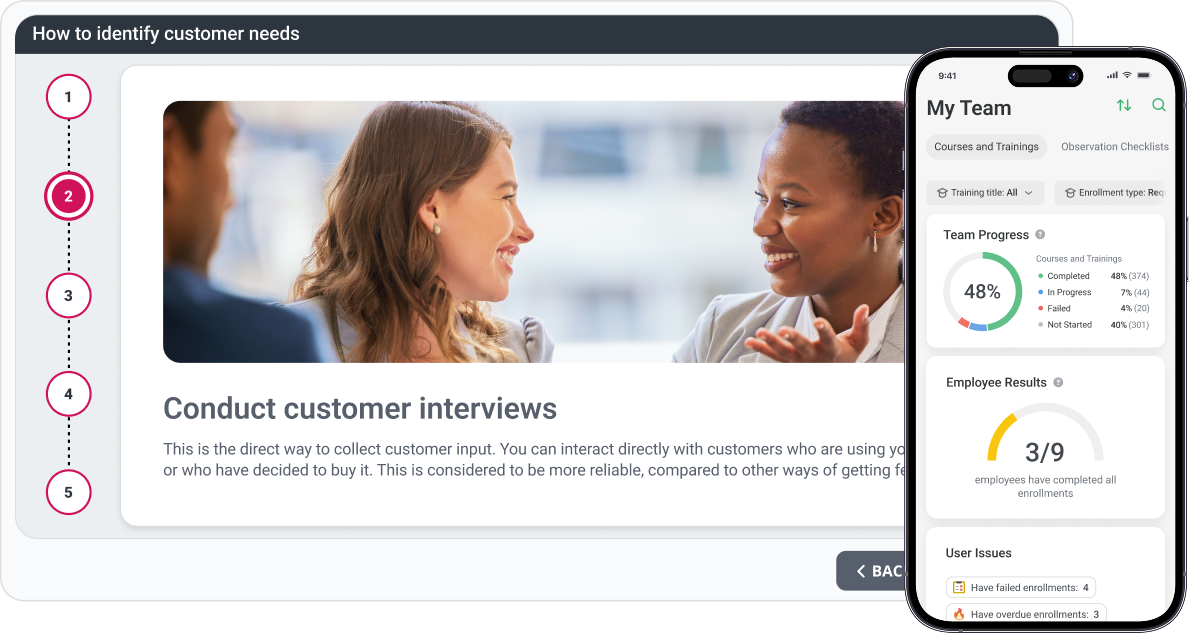
With this format, you use digital content to train employees. Here are the different types of content you can deliver with eLearning:
- Video-narrated content
- Screencast tutorials
- Branching scenarios
- Microlearning
eLearning is ideal for topics that require consistent delivery across large or globally dispersed teams, such as compliance, product knowledge, or technology training.
Blended learning

This approach is about getting the best of both worlds: face-to-face learning and online learning.
This means that employees might start with eLearning modules to understand the basics of a topic, then attend an in-person workshop for practice, and finally complete follow-up eLearning modules to reinforce skills.
Blended approaches require careful coordination to avoid duplication or overload. An LMS can help manage the online and in-person sequencing to ensure that employees don’t miss anything.
6. Choose an LMS built to deliver training at scale
A learning management system (LMS) is the engine that powers the entire strategy. A well-designed enterprise learning strategy sets direction, but without the right system to deliver, track, and scale training, it can’t succeed.
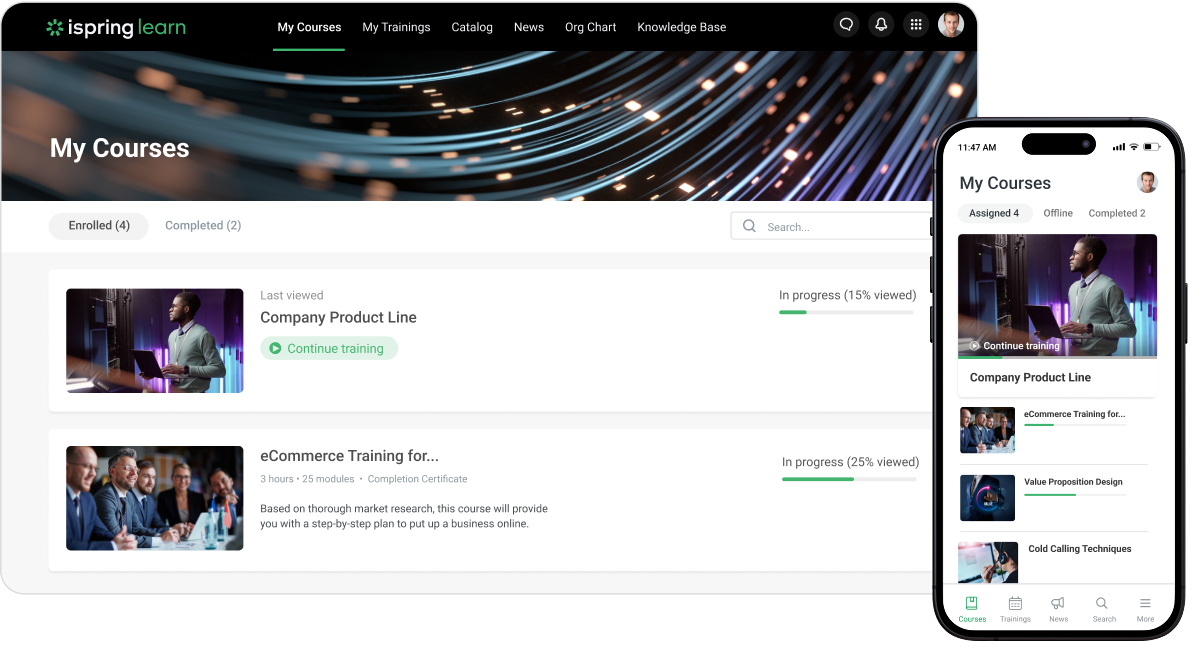
Before you start thinking about an enterprise learning strategy, consider that your LMS requirements may have been minimal, or you may have relied on other tools to manage employee learning.
Here’s what to consider when choosing an enterprise learning management system:
- Ease of use. Simple for both admins and learners to boost adoption.
- Global flexibility. Supports distributed teams, multiple languages, and local management.
- Scalability and speed. Handles thousands of users and enables fast rollout.
- Integrated tools. Combines course creation and delivery in one system.
- Personalized learning paths. Organizes training into a tailored learning journey that fits each role, skill, and career goal.
- Engagement and impact. Drive learner participation and link to measurable learning outcomes.
- Reliability. Stable, secure, and dependable under heavy use.
iSpring LMS is a comprehensive learning platform that meets these requirements and offers other features you’ll need to implement your enterprise learning strategy:
- Authoring integration. iSpring LMS has a built-in AI-powered scrollable course builder. You can put together beautiful stories with illustrations, quotes, videos, quizzes, and interactions. No technical skills are required.
- Content support: It works with multiple formats, including videos, documents, quizzes, and SCORM courses.
- Integrations: Connect with tools like Zoom and Microsoft Teams for live, instructor-led training.
- Gamification: Employees can earn points and badges and keep an eye on their position on leaderboards.
- Mobile access: Give learners the ability to train on the go, even offline.
- Analytics: Track learner progress, completion rates, and performance data in detail.
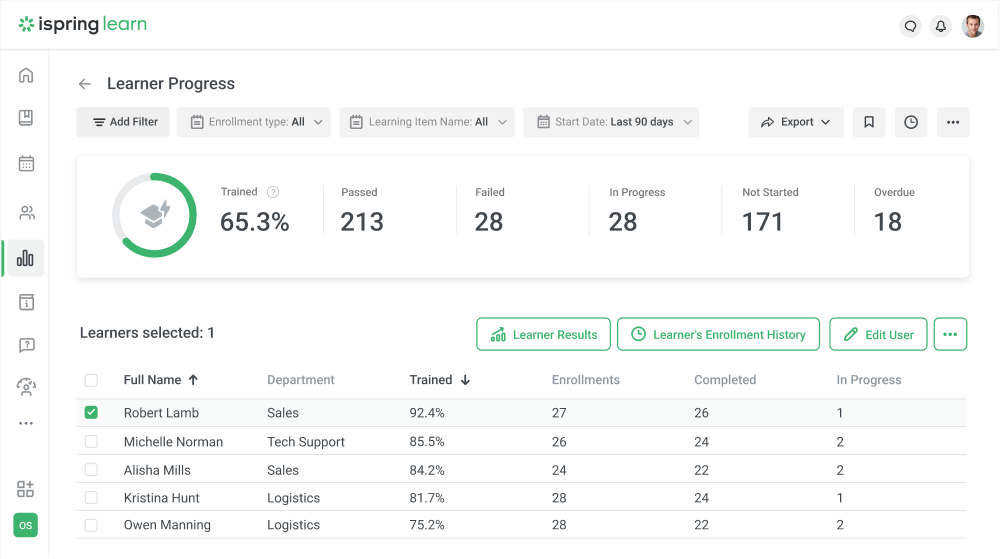
iSpring LMS dashboard
Here’s how some companies have used iSpring LMS to support their enterprise learning programs:
NAOS: Cutting training expenses to a quarter of the previous cost
When COVID hit, NAOS, a global skincare company with 3,000+ employees, had to move fast. Using iSpring LMS, they launched their first online training program in just 3 months and rolled out 5 learning tracks for brands like Bioderma and Esthederm. Trainers with no design background turned simple PowerPoint slides into interactive courses with voiceovers, quizzes, and simulations in under 30 minutes.
The switch also made training more flexible. Employees could learn anytime, anywhere, and join live sessions on Teams, all managed in iSpring LMS with automatic schedules and progress tracking.
The results speak for themselves: 113 employees trained across multiple countries, training costs reduced by 25%, and expensive travel reduced from 14+ trips per trainer per year.
IMT Matcher: Cutting training costs while scaling globally
IMT Matcher, a provider of IVF management technologies, was relying heavily on video calls and face-to-face training. The approach worked, but it quickly became expensive and time-consuming.
They needed a faster, more affordable solution without sacrificing quality. By switching to iSpring Suite to build interactive learning programs and iSpring LMS to organize them into learning paths and deliver them, they gave learners the flexibility to complete training at their own pace while still tracking progress through built-in analytics.
This resulted in a reduction in development time and a 25% drop in training costs, resulting in 28 learning tracks on iSpring LMS.
7. Plan logistics and delivery
Here’s where you work with stakeholders to nail down the timeline, resources, and budget for the training programs.
- Define deliverables: Spell out exactly what needs to be produced, like microlearning modules, virtual workshops, job aids, etc.
- Establish a timeline: Decide when the training needs to launch and work backward to set milestones for training design, development, review, pilot testing, and rollout.
- Allocate resources: Clarify who’s responsible for content creation, accuracy checks, LMS uploads, and communications. Confirm whether you’ll need external SMEs or extra tools.
- Estimate the budget: Factor in costs for external SMEs, content production, technology platforms (like an LMS), and any additional resources needed. Training Magazine’s 2024 Training Industry Report provides benchmark budgets per learner and learning area, segmented by company size.
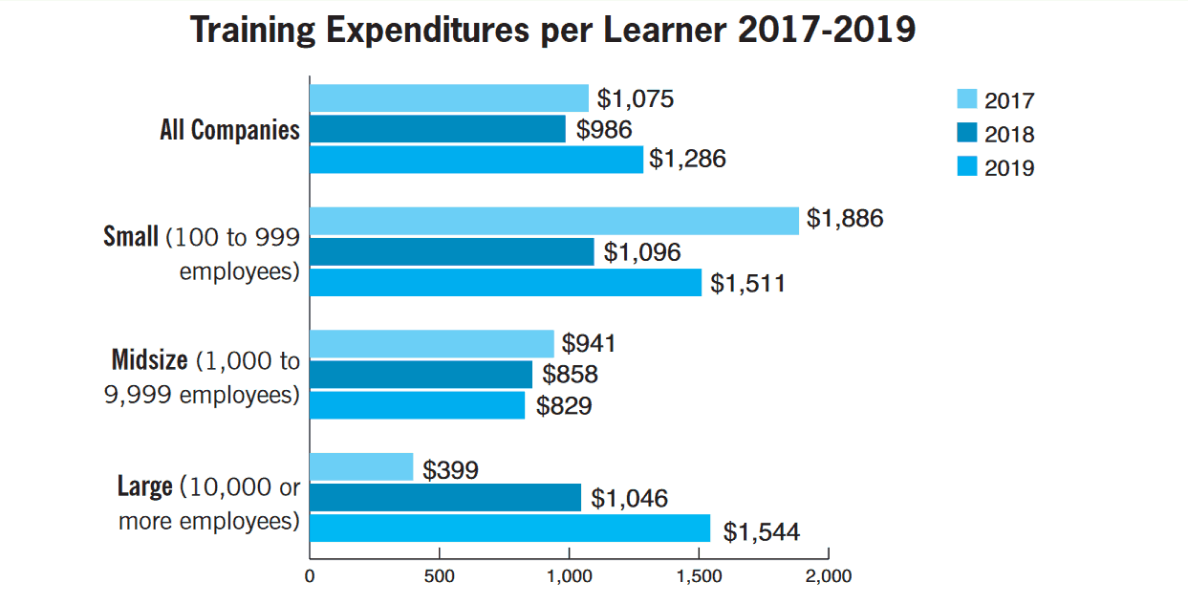
Training costs per learner, segmented by company size. Source: Training Magazine’s 2024 Training Industry Report.
8. Plan for measurement and evaluation
The final step in creating the right enterprise learning strategy for your business is ensuring that you can prove its impact.
There are many measurement and evaluation frameworks you can use, but the most popular is the Kirkpatrick Evaluation Model. It measures training effectiveness at four levels:
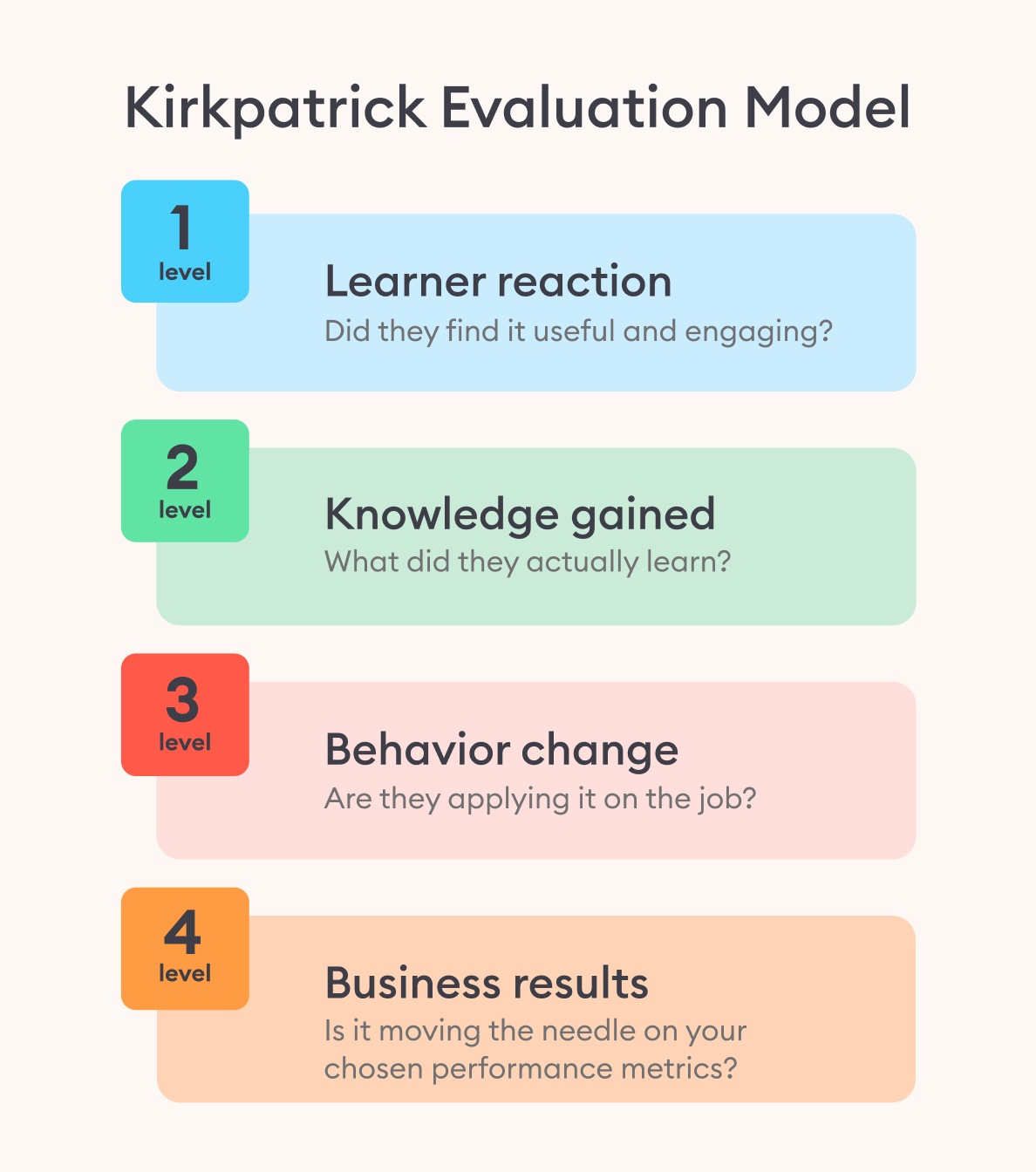
Decide upfront which metrics you’ll track before, during, and after training. You also need to work with managers to pull performance metrics from the tools they use, and team up with IT to build a centralized dashboard that brings all the data together in one place.
You can also take this a step further by calculating the ROI of your enterprise learning initiatives. It makes sense for large projects that require heavy investments or those tied directly to revenue growth.
Enterprise Learning Strategy Template
Want a simple way to create a robust enterprise learning strategy? Grab this free L&D strategy template. It walks you through the process step by step.
Inside, you’ll find everything you need to build a strategy that delivers results, including:
- Analyzing training needs and skill gaps.
- Setting learning objectives and the learning initiatives to support them.
- Outlining implementation, evaluation, and measurement plans.
- Creating a stakeholder engagement plan.
Key Challenges to Implementing an Enterprise Learning Strategy (and How to Overcome Them)
If you’re building an enterprise learning strategy for the first time, you’ll likely hit a few bumps along the way.
Here are some of the most common challenges L&D leaders face and practical ways to handle them.
Dealing with many training requests
Creating a learning strategy doesn’t mean the flood of training requests will suddenly stop — especially in the earliest phase.
But as a strategic L&D leader, your job is to focus on initiatives that tie directly to business results. That means learning to say “no” (or at least “not right now”) to requests that could derail your priorities.
The fix
When a request comes in from a department head, schedule a meeting with them along with one or two SMEs who understand the training topic well. Your goal is to understand: What business goal does it support? What do people need to do? Why aren’t they doing it? Is training the right fix?
If yes, check how closely it aligns with the learning goals you’ve already set. Move it forward if the link is strong. Otherwise, explain to the stakeholder that it will be noted for the next strategy review and why it isn’t a priority at this time.
Getting buy-in from leadership
One of the toughest parts of rolling out an extended enterprise learning strategy is convincing executives to support it. If they don’t see how training connects to business results, it’s difficult for them to justify the time and budget.
The fix
Start with a small learning goal and share the results to gain confidence and support for bigger projects down the road. L&D consultant Jess Almlie explains it well: “If you can’t create a full-on strategy right away or follow it, START SMALL. Choose one business goal or even one department’s goal to address, measure results, and then share the story of your success.”
Managing stakeholders
Rolling out a learning strategy isn’t a solo job. Executives control the budget, SMEs make sure training is accurate, and department heads help to link it to team performance. If you don’t manage these groups well, you’ll end up creating low-quality training content, running into delays, and finding it difficult to track key metrics.
Managing these groups means setting clear expectations for their role, keeping them in the loop with regular updates, and making it easy for them to give feedback when needed.
The fix
Use a power–influence grid to identify which stakeholders should be actively involved in shaping your learning strategy and training initiatives and which ones only need to receive regular updates on progress.
This might involve holding weekly check-ins with SMEs to confirm that work is on track, reviewing learning objectives and content with department heads to ensure accuracy and relevance, and reporting to senior leadership after rollout to demonstrate the impact of corporate training on business performance (and if applicable, ROI).
Build an Enterprise Learning Strategy that Drives Results with iSpring LMS
The foundation of creating a successful enterprise learning strategy is about asking the right questions (from senior leadership to department heads to team members), listening carefully, and connecting the dots.
But strategy alone isn’t enough.
To see measurable results and a positive ROI, you need the right tools to deliver training. A reliable LMS makes it possible to roll out enterprise learning programs on time and within budget and create learning initiatives that boost employee engagement and drive positive behavior change.
With iSpring LMS, you can deliver training programs seamlessly at scale.
Ready to see it in action? Request a demo of iSpring LMS today to make your learning strategy a success.
FAQ on Enterprise Learning Strategy
What is the meaning of enterprise learning?
Enterprise learning refers to a holistic, strategic approach to employee development and training in large organizations. It involves identifying business goals, creating a consistent learning strategy, consolidating resources, setting up systems to assess and monitor progress, and choosing the right tools (such as an LMS) to deliver learning effectively at scale.
What are the 4 learning strategies?
The four main learning strategies are:
- Employee onboarding – helping new hires ramp up quickly and confidently.
- Compliance training – ensuring that employees meet legal and industry standards.
- Capability development – reskilling, upskilling, leadership development, and product knowledge.
- Customer and partner training – enabling external audiences to use, sell, or support your products effectively.
What is an enterprise learning strategy?
An enterprise learning strategy is a structured plan that shows how learning will close skill gaps, improve business processes, and achieve organizational goals. Unlike smaller companies, enterprises need intentional, scalable programs that align with business priorities, engage diverse learners, and prove measurable impact.






